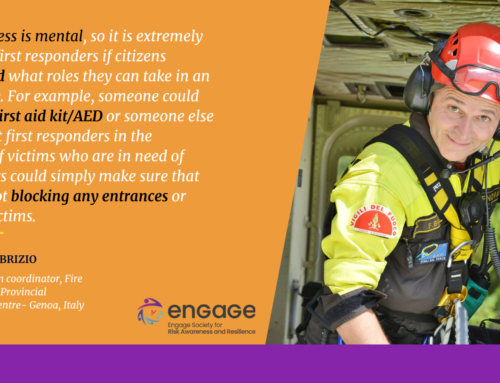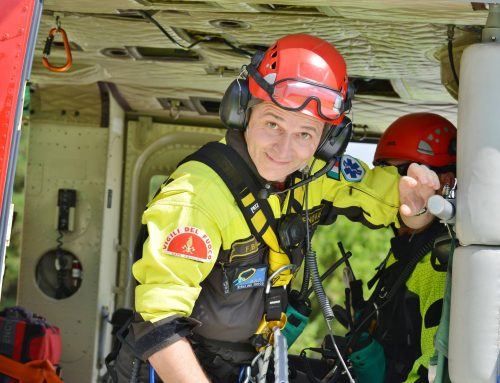I would like to explain this in the following. I have to admit that the term “societal resilience” may not be as young as Virtual Operations Support Teams (VOST), but with the COVID-19 pandemic, it almost feels like the term has been rejuvenated. It is high on the agenda of many publications that are highlighting the impact of the pandemic on society. The definition makes it clear why: societal resilience is the ability of a human community to cope with and adapt to burdens such as social, political, environmental or economic change. COVID-19 undoubtedly stressed all areas. For societal resilience, or the strength of its expression, some factors play a very special role, e.g. social networks, social capital and social relationships. And now we are suddenly very close to VOSTs. Here we also should briefly explain what these are. VOSTs are support units in disaster management that can generate additional information for crisis teams, decision-makers and authorities by sifting through the usual flood of data for relevant information in the event of a crisis or disaster. After the triumph of online networks and mobile internet, the flood of available information proved almost impossible to keep track of. VOSTs employ experts who not only feel at home in the field of social networks and internet technologies, but also have experience in disaster management. Another advantage: crisis teams and decision-makers can access additional information without having to plan their own personnel capacities.
For social networks, human interaction, society, trust in each other and among each other plays a very important role. Trust is the conviction of an individual that an action, an insight or a statement is correct, corresponds to the truth or is honest. Mutual trust has a strengthening effect on the (societal) resilience of a society. The COVID-19 pandemic put this to the test everywhere in Europe and also worldwide, because the already existing uncertainty due to the new virus and the initially vague state of knowledge shook society and even managed to divide it in parts. Suddenly there were Corona deniers who questioned the protective measures taken by governments, judged them to be exaggerated or denied the existence of the virus altogether. Wild conspiracy theories made the rounds, claiming to be substantiated by dubious studies or studies taken completely out of context. Recommendations for action also made the rounds, supposedly explaining how to minimise the risk of infection with the coronavirus. Some of these instructions, if followed, could have resulted in serious health consequences or even death. In no time, crisis teams, health authorities and decision-makers were confronted with a barrage of disinformation that had to be countered. At the same time, it was a matter of providing the population with adequate information and at the same time combating possible losses of confidence. This is precisely where VOSTs can be used to great effect. There is no network where fake news and disinformation spread faster than the internet, which has innumerable social networks, each of which has interfaces with the others. The effort is low, costs are basically non-existent and at first glance, there is also a kind of anonymity. Targeted fake news or disinformation spread in this way at lightning speed. Undeveloped or missing media competence makes the identification of such information even more difficult. The detection of fake news and disinformation on the internet is one of the core tasks of a VOST. Ideally, such fake news are identified at an early stage and transmitted to the client (e.g. a health authority) so that the latter can debunk the disinformation in its own public relations work. Here, a VOST can also be supportive and assist the authority in communicating through its own network. Another advantage is that VOSTs are closely networked within Europe and worldwide and are in constant exchange. In this way, fake news can sometimes be identified before they circulate in the networks in their own national language.
The past has also shown that in resilient societies, groups emerge during crises and disasters to offer support and help. As they often organise themselves through social networks, identifying them through a VOST can provide helpful information to governmental structures or local authorities about additional resources available to support the regularly alerted responders. At the same time, a VOST would be able to identify needs expressed in the respective social networks in order to support the responsible crisis team in decision-making or prioritisation. For example, one could think of volunteers who are thirsty for action and would be willing to fill sandbags in the event of an impending flood, but who do not have shovels.
Today, digital social networks are indispensable and have become, to a small extent, a mirror of society. They are colourful and diverse, united in the interest of a quick exchange of information. They are certainly capable of strengthening societal resilience, but they are also exposed to dangers that can undermine trust in civil society and state structures. Virtual Operations Support Teams can make an important contribution to identifying these threats and making societal resilience less vulnerable to disruptive impacts. As part of digital social networks, VOSTs can be used to promote and strengthen societal resilience by detecting needs at an early stage. Finally, to return to the initial question: Societal resilience and Virtual Operations Support Teams – do they go together? Extremely well, in fact! #WeAreVOST
Author: Volker Tondorf, Cross-border Emergency Care & Civil Protection, VOST Europe




